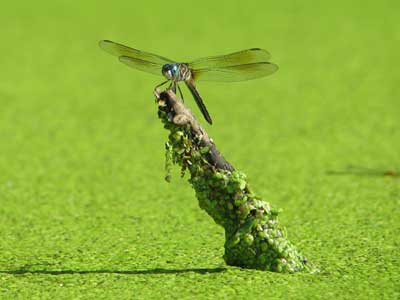
Photo by [Schick] morgueFile
The giant insects that roamed the Earth were no exception to this, because as we learned during the discussion New Antibiotic Found in Cockroaches Brains, approximately 80% of all animals on Earth are insects. There was a day that dragonflies were predatory creatures and had a wingspan similar to that of a modern seagull, but remember this was some 300 million years ago. But dragonflies were not the only giant insects during that time…
What Caused them to Become Giant Insects
According to studies, it is believed the main factor attributed to how these giant insects came to be was the amount of oxygen present in the atmosphere during those times.
Theories speculate there was extremely high levels of oxygen present and in order for the insects to survive, their bodies had to support an oxygen rich environment. So basically they adapted to grow much larger in order to absorb more oxygen from the air. This was their bodies defense for avoiding oxygen poisoning.
According to research, it’s believed that the higher oxygen levels not only effected the adult insects but the larvae were effected as well. This meant the evolution of them becoming giant began from birth.
How did the Giant Insects Use the Oxygen to Their Advantage
During the Carboniferous period, giant dragonflies and giant cockroaches were extremely common. This was partly due to the large number of lowland swamp forests that were present at the time. And as we all know, the more plant life you have, the higher the oxygen levels will be. It is believed there was approximately 30% oxygen present in the air at that time, which is nearly 50% higher than it is today.
Seeing how the oxygen was so dominant, the adult insects were able to grow larger in size and still meet their energy needs. Another study that focused on stonefly larvae showed that the higher the oxygen level is in the air, the higher it will be in the water. These stonefly larvae were similar to dragonflies in the way they started out in water before becoming adults. This being the case, it allowed scientists to see that the larval stage of development in any insect whether on land or in water could benefit from the higher concentration of oxygen.
It was also discovered that the baby stoneflies were more sensitive to the changes in oxygen than their adult counterparts. This is probably because the larvae would absorb the oxygen directly through their skin rather than having to breathe it in. This meant they had little control on how much oxygen they would take in. Where as the adults could regulate this by they opening and closing of spiracles in their body. Spiracles are just little holes on their body that are used to take in oxygen.
Even though oxygen gas is essential for any living creature here on Earth, larger quantities of it can be dangerous and even poisonous. For instance in humans, by absorbing too much oxygen, we may suffer from damage to cells which could lead to problems with vision, breathing, nausea and even result in convulsions.
Giant insects only defense to oxygen poisoning would of been to grow larger in size, this would lessen the danger associated with taking in too much. Basically the way it was explained is that the larger your body is, the smaller surface area per volume you have.
What Happened when Oxygen Levels Decreased
As we all know, the oxygen levels decreased after millions of years of Earthly development, so what happened to the insects at this point you may ask. Well there is a theory as to how the giant insects continued to thrive even after the oxygen levels decreased.
Scientists say that even though larges doses of oxygen caused an increase in body mass with these insects, a decrease in the gas would not have an immediate effect on the insects. Lower levels would not be fatal at first, but over time it’s likely that giant insects population would decrease as the generations of insects began to grow smaller and smaller in size to meet the new oxygen levels requirements.
The decrease in oxygen would cause those adult insects to become sluggish and slower. And we all know what happens to the sluggish and slow within the animal kingdom… They eventually die out, by being taken over from another dominant species. That explains why we no longer see giant insects on Earth. Although I’ve seen a few that I’d consider giant, but they are nothing near the size of a seagull.
Tell me what you think, could you imagine living in a world that still had giant insects the size of a small mammal?



That’s a pretty natural and acceptable reason why these animals don’t exist anymore. It was nice to learn from the past! Great article and research!
Yah it really makes perfect sense when you put two and two together. Oxygen can be very poisonous in large quantities to all living creatures, so it stands to reason that over time species would adapt to counter act this. Glad you enjoyed reading.
I prefer to live in a world with small bugs and mosquitos. The small ones can be annoying too, but at least, they don’t take the whole head when they bite us. 😉
Great article. I wasn’t aware that the oxygen level was the reason for the giant insects.
You make a good point Christian, I would much rather deal with a small insect than one the size of a house…lol It’s really quite interesting how much the elements in our atmosphere can effect the growth of life on Earth. Oxygen being a major contributor to that process.
so the oxygen level has much to do with the size of a living organism also!
this means that if humans are ever subjected to a higher oxygen atmosphere, they will be stronger?
Informative article indeed!
That’s right Yogesh, not only would we be stronger, but much larger too 🙂
Thanks for sharing such informative blog…basically there are only few person who are interest to about the insect and their life and the rest of neglecting by saying they are the same aspect of earth but mainly they plays very important role in environment.
That’s true, although most people find the insects repulsive and disgusting, they do serve a purpose in this world whether it be for environmental aspects or for the natural order of things. I’m just glad they are no longer as huge as they used to be!
Yes indeed, almost everybody find insect disgusting because they think they don’t deserve to live on the planet earth…
It’s true Adesanmi, most insects do carry many diseases and are dirty creatures. It’s ironic that the unclean lives they live would cause them to produce bacteria fighting agents like in the cockroach.
Well-researched Rob, thank you. Damn, I wish we still had fireflies that big; would make the outdoors really interesting. Plus, there would be no need to lock your windows at night as insects would be too big to fit through them anyway, LOL!
But then again my question is this: if giant insects were eventually overtaken by smaller species (ones that did not become sluggish from the decrease in oxygen levels), then how come the SMALLER species did not get overtaken completely while the oxygen levels were still high?
Well Martin, the smaller species did not evolve until there was a decrease in oxygen. Therefore there would of been no competition for the larger species to take over during that time.
We have to remember that this was a process that evolved over a large span of years, maybe millions of years.
But let’s say that there were some smaller species on Earth at the time giants were roaming free… They would of most certainly been consumed as a food source I’m sure.
it’s realy good. Thanks for post.
Thank you for reading
Very interesting article. I wouldn’t be surprise if giant insects really existed before or even now. Dinosaurs were giant. But I definitely would not want to encounter a giant insect. It gives me the creeps.
Oh no doubt Luke! I would much rather come face to face with a T-Rex than a Giant Spider! 😀
It is still a mystery if giant insect were existed though I believe it.
Yah it is kind of hard to believe Neha, but there’s so much evidence to support that giants were once part of our planet that it’s kind of hard not to believe. I really appreciate you sharing your opinion with us.
thanks for stopping by!